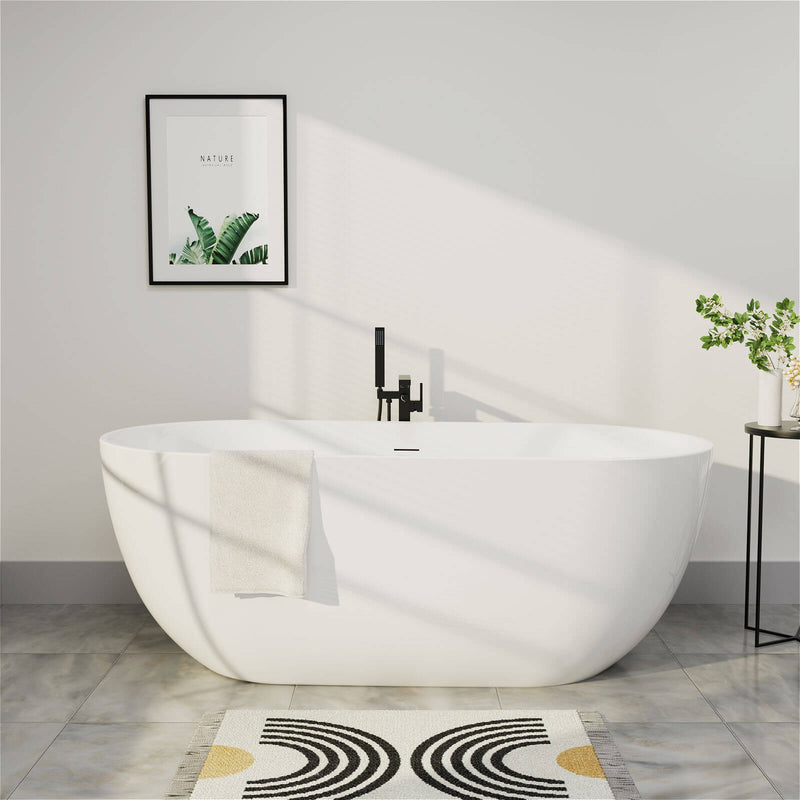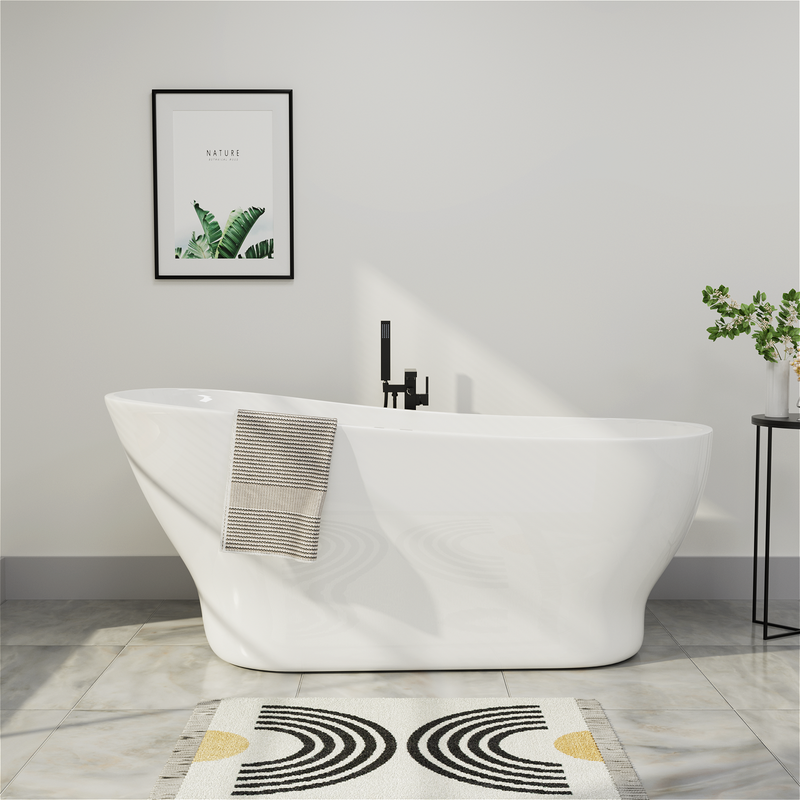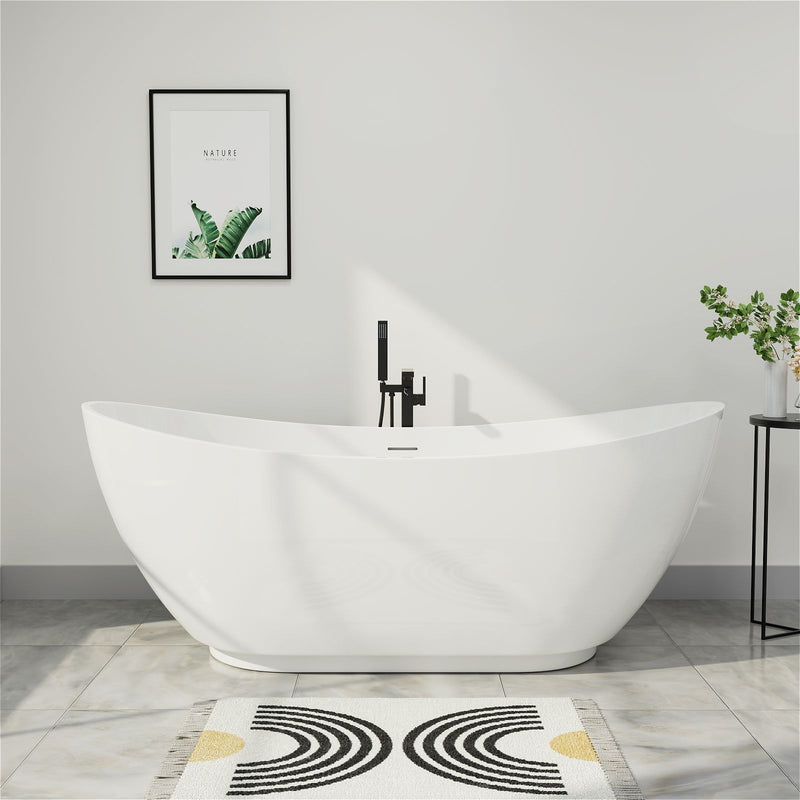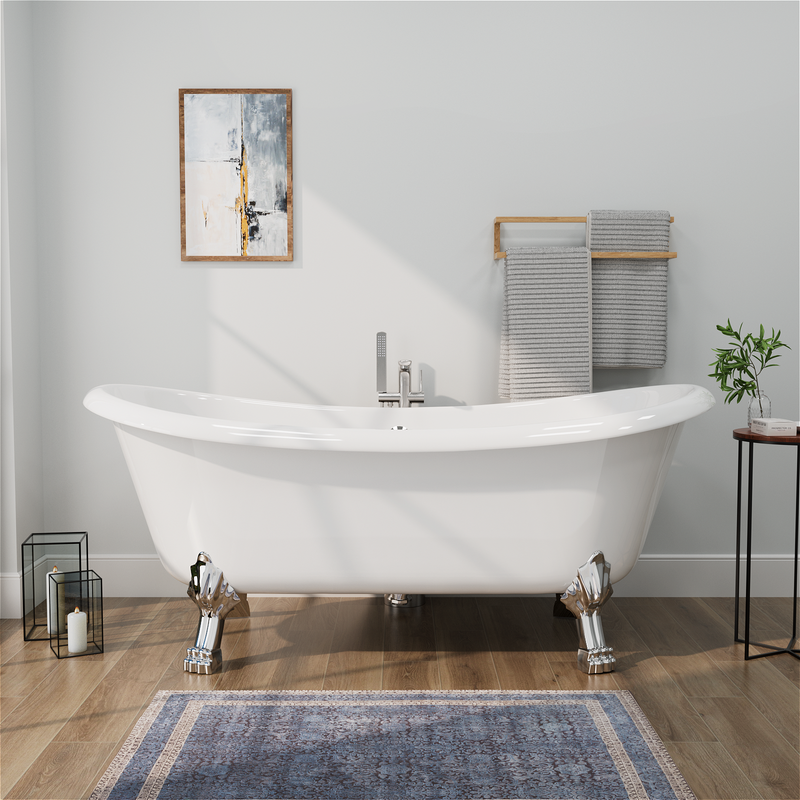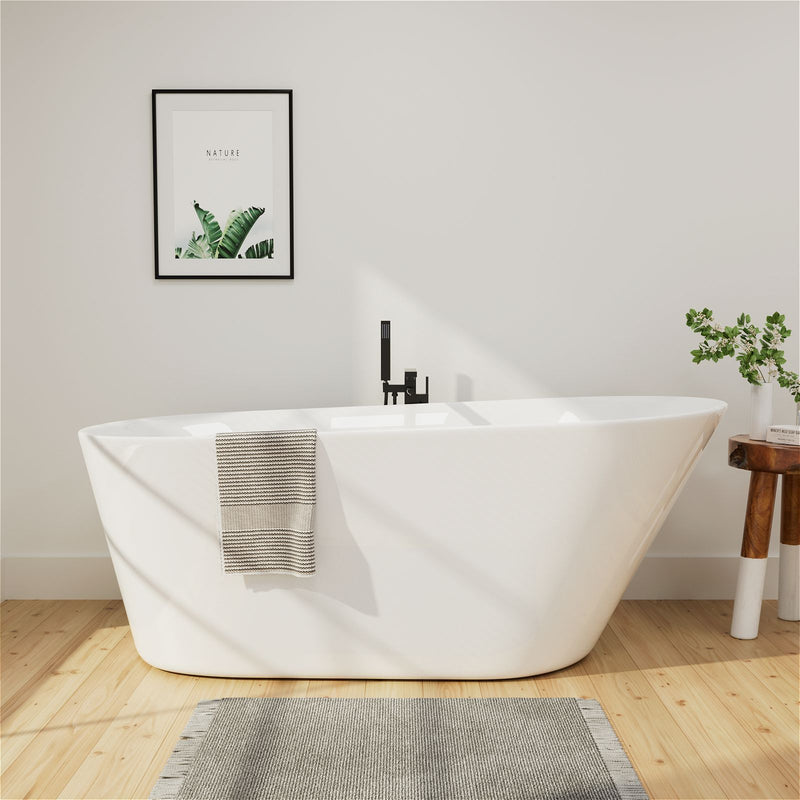The slipper bathtub, this cute name, actually comes from its unique appearance design - one end of the bathtub is raised high, like an upside-down slipper. This design is by no means accidental, but is to solve the century-old problem that traditional bathtubs are uncomfortable to lie in.

Imagine that when you lie down in an ordinary bathtub exhausted, your head has nowhere to rest, and you can only awkwardly lean against the hard wall of the bathtub. The towering backrest of the slipper bathtub is like a pillow tailored for you, giving your neck perfect support. This ergonomic design can be traced back to the European aristocratic bathroom in the 19th century.
History of the Slipper Bathtub
The earliest slipper bathtub originated from Victorian laundries and bathhouses. At that time, diseases were rampant among the population, and one of the ways that experts at the time tried to control diseases was to tell people to clean and bathe regularly. However, in Victorian Britain, unless you were rich, working-class and middle-class families usually did not have their own bathtubs - if people took a bath, they would take a small bathtub placed in front of the stove. So, the slipper bathtub came into being.
But why this shape? The higher curved end of the bathtub was originally designed to provide extra privacy for the bather. The deeper end also allows users to relax in more water, while the faucet on the shallow end is out of the way. For privacy, users also put towels on the shallow end to make them look like slippers.
Today, slipper bathtubs are still very suitable for family bathing, because the shape of slipper bathtubs helps to keep hot water hot longer. And in today's families, bathing is often not only a means of staying clean, but also a relaxing activity.
Types of Slipper Bathtubs
In modern bathroom design, slipper bathtubs have become the first choice for people who pursue bathing quality with their unique ergonomic shape and elegant aesthetic style. The most notable feature of this bathtub is its towering backrest design, which looks like an inverted slipper, hence the name. After more than two centuries of development and evolution, today's slipper bathtubs are mainly divided into two types: single slipper design and double slipper design, each design contains a unique design concept and user experience.

Single Slipper Bathtub: The Perfect Balance Between Classic and Practical
Single slipper bathtubs represent the most traditional design form, characterized by a raised backrest at only one end of the bathtub. This asymmetrical design is not accidental, but a carefully calculated ergonomic consideration. When the user is half-lying in the bathtub, the raised side can perfectly support the back curve, especially the lumbar and cervical vertebrae. According to anthropometric research, the ideal backrest height should be between 50-70 cm, and the tilt angle is best at 105-110 degrees, which is the standard parameter adopted by most high-quality single slipper bathtubs.
In terms of size specifications, single slipper bathtubs show amazing diversity. The length of traditional styles is usually between 60 inches (about 152 cm) and 72 inches (about 183 cm), which can meet the needs of people of different heights from 1.5 meters to 1.9 meters. The width varies from 30 inches (about 76 cm) to 36 inches (about 91 cm), which ensures sufficient space for activities without excessively occupying the bathroom area. It is worth noting that modern design pays more attention to the optimization of internal space. Through precise arc calculation, the internal use space is expanded to the greatest extent while keeping the external dimensions unchanged.
The choice of installation method also reflects the flexibility of the single slipper bathtub. Wall-mounted installation is suitable for small-space bathrooms and can create a simple visual effect; countertop installation is convenient for hiding the pipeline system and creating a neat bathroom environment; and freestanding installation can show the beauty of the bathtub itself and become the visual focus of the bathroom. Different installation methods also have special requirements for the selection of faucets. Wall-mounted faucets require pre-buried pipes in advance, while countertop faucets must consider the coordination with the edge of the bathtub.
In terms of material technology, modern single slipper bathtubs break through the traditional cast iron restrictions. High-end acrylic materials are strengthened through multiple layers, which not only maintains a warm touch, but also has sufficient structural strength. Some innovative models even use composite mineral materials to simulate the texture of natural stone, while solving the shortcomings of stone absorbing water and getting dirty. In terms of manufacturing technology, the one-piece molding production technology ensures a seamless and perfect surface, which is not only beautiful, but also eliminates the hidden danger of leakage.
Double Slipper Bathtub: The Art of Luxurious Bathing
Double slipper bathtubs represent the ultimate pursuit of bathing culture. Their biggest feature is that they have elevated backrests at both ends of the bathtub. This symmetrical design is not only an innovation in appearance, but also redefines the experience of bathing together. The elevated design at both ends allows users to get perfect back support no matter which side they choose, which is especially suitable for couples or families to enjoy bathing together. The design of the central drainage system is even more ingenious, avoiding the water flow noise and uneven temperature problems caused by traditional end drainage.
In terms of size specifications, double slipper bathtubs show a more atmospheric sense of space. The length range is usually between 65 inches (about 165 cm) and 78 inches (about 198 cm). This size can ensure the comfort of two users without excessively squeezing the bathroom space. The width is between 35 inches (about 89 cm) and 40 inches (about 102 cm), creating a more spacious bathing environment. It is particularly worth mentioning that some customized double slipper bathtubs can reach a depth of up to 75 cm, creating a nearly fully immersive bathing experience, allowing users to completely relax every inch of their muscles.
In terms of installation method, double slipper bathtubs emphasize visual impact. Freestanding installation is the most popular choice, making the bathtub the absolute center of the bathroom. Considering its large size and weight, special attention should be paid to the load-bearing capacity of the ground during installation, and structural reinforcement should be carried out if necessary. In terms of faucet configuration, in addition to the traditional central installation method, modern designs prefer wall-mounted or floor-standing faucets, which not only save space but also create an effect like an art installation.
In terms of material selection, double slipper bathtubs often use higher-end materials. Natural stone composite materials are the first choice for top models, which not only maintains the luxurious texture of stone, but also solves the weight and temperature conduction problems through special treatment. Some limited edition products even use semi-precious stone inlays or precious metal edging to elevate practical bathroom products to the level of works of art. In terms of internal structure, the use of multi-layer composite materials ensures the thermal insulation performance of the bathtub. Test data shows that the water temperature of a high-quality double slipper bathtub drops more than 40% slower than that of an ordinary bathtub.

Ingenuity in Design Details
Whether it is a single slipper or a double slipper design, modern high-end bathtubs have devoted a lot of effort to detail processing. The design of the anti-slip texture should not affect the comfort too obviously, but also ensure sufficient safety. Usually, a micro-concave and convex structure is used to solve this contradiction. The hidden design of the overflow port is also a highlight. The overflow is guided to the drainage system through a clever channel while maintaining a simple and smooth appearance.
The processing of the edge curve is a place where the design skills are reflected. Too sharp corners will bring safety hazards, while too blunt corners will appear bulky. The best solution is to use a gradual curvature, using a larger arc in the part that contacts the body, and keeping a neat line at the visual edge. This treatment method not only ensures the comfort of use, but also creates an elegant visual effect.
Color processing technology also makes modern slipper bathtubs present unprecedented diversity. In addition to traditional solid colors, gradient colors, pearlescent effects and even imitation natural stone textures can be achieved through advanced surface treatment technology. Some brands have also developed temperature-sensitive color-changing coatings. When the water temperature exceeds 40 degrees, the bathtub surface will show special patterns or colors, which is both practical and interesting.
The innovative design of the drainage system is also commendable. The drainage noise problem of traditional bathtubs has been perfectly solved in modern slipper bathtubs. The combination of silencer drain pipes and buffer drain valves is used to control the drainage noise below 40 decibels, which will hardly disturb family members outside the bathroom. The application of the fast drainage system also shortens the draining time by more than 50%, greatly improving the efficiency of use.
The integration of the lighting system is another innovation. The LED atmosphere light is cleverly embedded in the edge of the bathtub, which can serve as a night guide light and create a romantic bathing atmosphere. High-end models are even equipped with a color therapy system, which stimulates different colors of light to help relax or boost spirits.
Slipper Bathtub Design
From single slippers to double slippers, modern bathtub design has surpassed the simple bathing function and has become a complex that integrates ergonomics, material science and art design. Every curve, every material, and every detail has been carefully considered to create the ultimate bathing experience. In this era of pursuing quality of life, choosing a suitable slipper bathtub is choosing a refined lifestyle.
Claw-foot Bathtub: Classical Beauty That Transcends Time and Space
The claw-foot bathtub is the most historical style among slipper bathtubs. This design first appeared in the Victorian period, when craftsmen designed the bottom of the bathtub into the shape of various animal claws, which not only played a supporting role, but also gave the bathtub a unique artistic temperament. In modern bathroom design, claw-foot bathtubs still maintain this elegant tradition.
The most classic is the lion claw foot style, where each leg is carefully carved into the shape of a lion's claw, and even clear claw nail textures and muscle lines can be seen in the details. This design originated from the European royal family's worship of power, symbolizing that the bathtub can bear the weight of the user as firmly as a lion. In comparison, the Emperor's Foot is more restrained and elegant. Its shape is inspired by the ancient Greek Corinthian columns, and the spiral lines reveal a strong classical atmosphere.
It is worth noting that modern claw-foot bathtubs have more choices in materials. In addition to traditional cast iron materials, claw-foot bathtubs made of acrylic and fiberglass composite materials are lighter, but through exquisite surface treatment technology, they can still perfectly reproduce the texture of classical cast iron. Some high-end brands even use solid brass to cast the legs, which, after special oxidation treatment, present a retro luster that has been baptized by the years.
This type of bathtub is most suitable for traditional or neoclassical bathroom spaces. When it complements the retro brass faucet, mosaic floor and carved mirror frame, it seems to make people instantly travel back to the aristocratic era of bathing rituals. However, it should be noted that claw-foot bathtubs require a larger installation space. It is usually recommended that the bathroom area should be no less than 8 square meters to fully display its elegant temperament.
Freestanding Slipper Bathtub: The Perfect Interpretation of Modern Minimalism
In sharp contrast to the complex decoration of claw-foot bathtubs, freestanding slipper bathtubs emphasize simple lines. This type of bathtub is placed directly on the bathroom floor, abandoning all unnecessary decorative elements, and only showing the design beauty through smooth curves and precise proportions.

The most notable feature of modern freestanding slipper bathtubs is their one-piece shape. The high-quality acrylic material is processed by hot bending technology to achieve a perfect arc that is difficult to achieve with traditional materials. From the side, the outline of the bathtub is like an elegant wave, and the towering backrest naturally transitions to the spacious bathtub without any seams or edges. This seamless design is not only beautiful, but also avoids the problem of filth and dirt.
In terms of color application, freestanding slipper bathtubs are also bolder and more avant-garde. In addition to the classic pure white series, modern designers have launched a variety of dark styles from graphite gray to navy blue, and even translucent frosted effects. These novel color schemes make the bathtub itself the visual focus of the bathroom, especially suitable for urban elites who pursue individuality.
In terms of functionality, the freestanding design gives this type of bathtub unparalleled flexibility. Since it does not need to be installed against a wall, users can approach the bathtub from all directions, making cleaning and maintenance extremely convenient. Some innovative models are also equipped with LED mood lighting systems, with light shining from the bottom of the bathtub, creating a dreamy light and shadow effect at night.
Pedestal Slipper Bathtub: An Elegant Balance Between Tradition and Modernity
The pedestal slipper bathtub cleverly finds a balance between classical charm and modern pragmatism. The most notable feature of this type of bathtub is its integrated base design, which retains the solemnity of traditional claw-foot bathtubs and incorporates the convenience of modern freestanding bathtubs.
Structurally, the pedestal design integrates the bathtub with the supporting structure, usually made of the same material as the main body of the bathtub. This integrated treatment not only enhances the visual sense of integrity, but more importantly, improves the stability of the bathtub. Compared with freestanding bathtubs, the pedestal design can better disperse the user's weight, especially suitable for larger bathers.
In terms of design language, pedestal slipper bathtubs often adopt a simple top and complex bottom treatment method. The main body of the bathtub maintains simple and smooth lines, while the base can be treated with different textures to add visual interest. For example, some high-end models will make the base surface look like natural stone, or embed metal decorative lines, adding exquisite details without destroying the overall simplicity.
This type of bathtub is relatively flexible in terms of the installation environment requirements, suitable for both traditional closed bathrooms and modern open bathroom spaces. Its moderate size makes it a good choice for small and medium-sized bathrooms, especially when combined with semi-recessed installation, which can further save space.
Conclusion
The slipper bathtub represents the perfect marriage of form and function, offering unparalleled comfort and timeless elegance for modern bathrooms. Whether you prefer the classic single slipper design for solo relaxation or the luxurious double slipper for shared bathing experiences, these bathtubs elevate everyday routines into spa-like indulgences. With thoughtful consideration of materials, size, and style, a slipper bathtub can transform your bathroom into a personal sanctuary for years to come.

